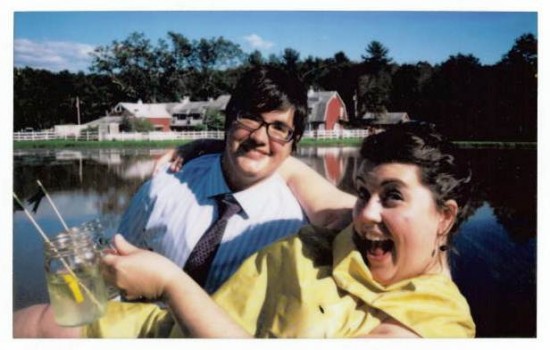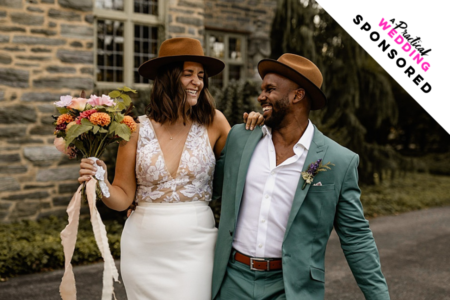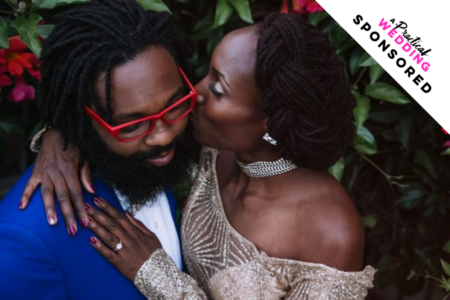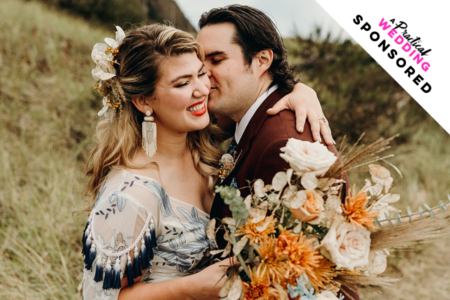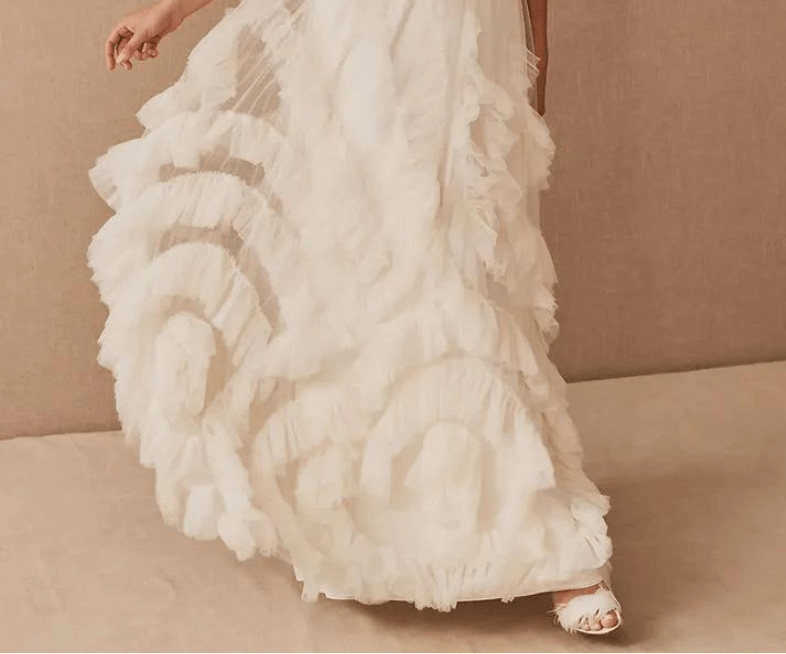Writing for APW about wedding planning and our looming wedding (less than a hundred days now, yikes) has made me a more thoughtful and disciplined writer, but I’ve also noticed it’s slightly changed the dialogue between my partner K and me. She’s read every post I’ve written before publishing, and she follows all the comments, and she’s noted that those conversations have been enlightening. (Because, lez be real, we don’t always listen to each other, and we definitely do not always agree.) Originally, I asked her to comment on a few of my posts so she could clarify or further explain her opinions. She said she’d think about it, and a few weeks later we were having a picnic on Bear Mountain when she turned to me and said, “I’ve been thinking. Should I write out MY thoughts on wedding planning?” Heck yeah, my taciturn girlfriend! So this week, K’s here to write about why she’s getting married.
As E and I sat down last week to finally finish off the Paperless Post invite, it was clear we were about to have another one of our ceremony-induced difficult dialogs. You’re supposed to tell your guests that you would be honored to request their presence at your marriage or to celebrate your wedding—but I haven’t been using any of these terms. I’ve just been calling it our legally binding clambake. I know this makes E crazy, and she struggles to see why I’m so hung up on the semantics, but the language really matters to me.
I never once dreamed of getting married as a kid. I grew up in a just-off-the-commune hippie family, and weddings and settling down and living that kind of “normal” life just weren’t on my radar. It’d be easy to think that I wasn’t imagining a wedded future because I was growing up a gay kid in the Midwest in the ’80s. That would certainly be a good guess. I’m one of those gays who’s always kind of known I wasn’t straight, but I don’t think that’s really it; I know plenty of queers, E for one, who imagined weddings for themselves without ever imagining opposite sex partners. But not me. I assumed I’d be on the campaign trail or living in a Catholic Worker house or chaining myself to a redwood; none of those imagined futures involved being paired off or exchanging rings.
At twenty-two, when I graduated college, I worked on a political campaign (based in the “east coast of Iowa” as we liked to call it when we were feeling cosmopolitan), and I regularly met up at the local gay bar in Davenport with some forty-something UPS-driving and factory-working lesbians. These were folks who’d come out in the late ’70s and had endured a lot of shit, but had an incredibly strong community to show for it. The relationship model that most of them seemed to use wasn’t really anything like straight marriage; they partnered off and lived together (usually swiftly: they’re lesbians, after all), but when the relationships didn’t work anymore—be that three months or fifteen years in—they broke up, moved out, moved on, and mostly stayed friends. With bumps in the road, sure, but the process was remarkably civil. The relationships weren’t thought of as failures at all; they were just over and everyone moved on. There were lots of downsides I’m sure; for one, most of them didn’t seem to see having kids as an option, and maybe that was a unspoken sadness for some, but they seemed mostly pretty content to twenty-two-year-old me down the bar. I wasn’t thinking about it too hard, but that seemed like a culture I wanted to be in: date, fall in love, live together, but when it doesn’t work, move on.
But here I am a decade later, getting ready for my final suit fitting for the clambake. I can’t pin down what changed. The Davenport model worked for me pretty well for the ensuing decade—I was happy to date, fall in love, move in, and then civilly move on—and I wish I could better articulate what’s different in this relationship. I met E and soon thereafter (though not the night we met as she likes to believe) I realized that I was imagining a forever future with her, something I hadn’t done with the previous women I’d dated. I totally understand why that Davenport model had worked for me and continues to work for lots of folks (and I think that one of the problems of the gay marriage movement is this variety of relationship patterns is being lost, but that’s another post entirely), but nevertheless, somehow, something changed and I wanted forever. Even if that forever means So Much Processing.
But the packaging and terminology still make me squirm. You’re heard from E about my ambiguity or even hostility towards all the associated terms—engagement, wedding, wife, all of it. I avoid them as much as possible. They don’t feel like they apply to me. I work for a progressive church organization, but I’ve kept the upcoming ceremony quiet from most of my colleagues. I was meeting with the president of the organization a few weeks ago and he was asking about whether we could schedule a day for staff to volunteer on our Sandy response projects on a Saturday in late September. How about the 21st? Well, not really. Why not, he asked. Well, I’m getting married that day. His face lit up: Congratulations! Where? When? Why hadn’t I told him earlier? Where’s my ring? Who’s my fiancé? He gave me a hearty handshake, and I answered as quickly as I could and dashed back to my office. It’s not that kind of engagement and I’m not wearing a ring and I don’t want to or know how to explain that to him.
Where would I even start? Folks often want to look at lesbian relationships and find out “who’s the man”—who’s the butch one, who does the man things. As much as I want to expose the simplicity and fallacy of such binary thinking, weddings make that really hard. I will be the one wearing the suit; E will be wearing a dress. I don’t feel comfortable wearing jewelry, certainly not diamonds, and she’s inching her way toward wearing a giant family rock. I don’t want a shower, I’m happy to leave the flowers to E and her friends, etc. etc. etc. But I’m not the groom (though I don’t want to be called a bride either). It feels like there’s space for a lesbian double bride wedding, where both women wear dresses and their dads walk them down the aisle and both families split the cost for the rehearsal dinner, and they enact the traditions that way. And there’s space for a lesbian bride/groom wedding, where the dress-wearer is walked down the aisle by her father and the suit-wearer waits up front with the celebrant, and you enact the traditions that way. But I’m not sure what to call it or what to do when I don’t want to be either.
And to further complicate matters, gender is only a piece of it. I think my family’s distrust for the mainstream actually is probably at least as much of a factor. My parents have been married for forty-two years now; they got married in college in an attempt to improve my dad’s application for conscientious objector status for the draft. They got married and they stayed married, but wedding wasn’t particularly a big deal to them. Their wedding was thrown and attended primarily by my grandfather’s bricklayer friends; it was in February during my parents’ senior year in college so not many of their friends made the three hundred-mile drive to my mom’s hometown. They believe, and to some extent I believe, that how you spend your money is a reflection of your values, and our lives should always be oriented toward creating more justice in the world. That doesn’t always leave much space for frivolity and, thus, weddings. And how you live your life, live your marriage, matters more than how the first day goes. I have toned down these values a little bit and created space for myself to care about how I dress and go to movies on occasion, but I still fundamentally hold those values to be true, and I can’t help looking at every expense through that justice lens. I see how this, perhaps, puts a damper on E’s fun planning her fanciful tree puff decorations.
But here I am, language and ceremony ambiguity and all, about to have this legally binding clambake. A friend once described marriage as a choice to be loyal to a person; that unlike the Davenport dating model, marriage is choosing to be loyal even when things aren’t smooth and easy, choosing to stay when you want to leave. It’s fundamentally different than dating for a long time. I like this idea of choosing to be loyal, even though I don’t like how it’s often practiced by our culture. When we started telling people we were having this legally binding clambake, another friend talked about how these ceremonies create a space for folks to put your relationship in the context of all the other relationships like it that they’ve seen, to enter that stream of cultural stories about lifelong partnership. And I do love that idea: that whatever we’re calling it, E and I are choosing to set out on this path that’s been taken by countless couples before us. I want to promise, in front of our community, to spend my life with E. I recognize that to most folks, that’s called a “wedding” and that the period before it is called an “engagement” and there are supposed to be rings and flowers and cake and then we use the word “wife.” But those terms all feel loaded by so much heteronormative, gendered, consumerist baggage. I’ve never felt welcomed by that world, and I’m not at all clamoring to join. But I do want to promise, in front of our community to spend my life with E, to be unfailingly loyal to her, when things are good and when things are hard, so here we are. It’s a legally binding clambake to me, it’s a wedding to her, and it’s in thirteen weeks. It will be wonderful to celebrate with her, and even more wonderful to spend forever with her.
Photo: From Elisabeth’s personal collection


